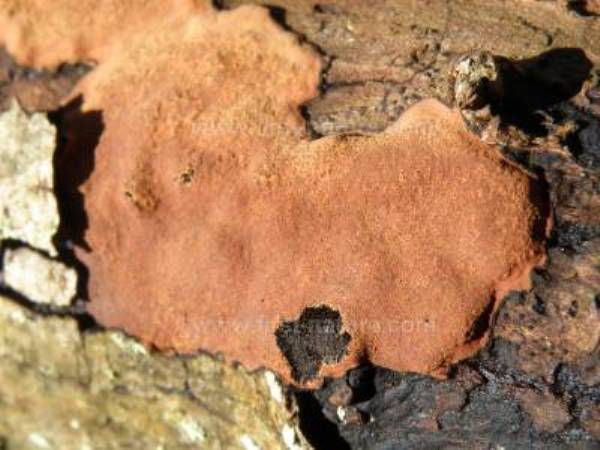Trees Birds Mammals Fish Amphibians Reptiles
Wild Algarve
Bookshop
Peniophora incarnata (Pers.) P. Karst. - Rosy Crust
Phylum: Basidiomycota - Class: Agaricomycetes - Order: Russulales - Family: Peniophoraceae
Distribution - Taxonomic History - Etymology - Identification - Culinary Notes - Reference Sources

A lovely reddish corticioid (crust) fungus, Peniophora incarnata is a very common in Britain and Ireland.
Distribution
Peniophora incarnata is abundant and widespread throughout Britain and Ireland. On mainland Europe this wood-rotting crust fungus can be found almost anywhere that hardwood trees occur.
Taxonomic history
This crust fungus was described in 1801 by Christiaan Hendrik Persoon, who gave it the scientific name Thelephora incarnata.
In 1889 Finnish mycologist Petter Adolf Karsten transferred this species to the genus Peniophora, and its scientific name, still generally accepted today, became Peniophora incarnata.
Synonyms of Peniophora incarnata include Thelephora incarnata Pers., and Corticium incarnatum (Pers.) Fr.
Etymology
Peniophora, the generic name, means tough, and crust fungi in this genus certainly can be difficult to tear when you want to take a small sample for investigation. The specific epithet incarnata refers to the reddish colour of this crust fungus.
Identification guide
 |
Fruitbody
Resupinate; the fertile surface is various shades of orange-red. |
| |
Spores
Cylindrical, smooth, 8-12 x 3.5-5.2µm.
Spore print
Mid pink to light red. |
Odour/taste |
No noticeable odour; tough, tasteless and inedible. |
Habitat & Ecological role |
Saprobic,on dead hardwood branches and twigs of many species. This crust fungus is often parasitised by Yellow Brain Tremella mesentrica. |
Season |
All through the year, shedding spores in
autumn. |
Similar species |
Oak Crust Peniophora quercina is a pale pinkish crust fungus found on oak branches and trunks.
Bleeding Rosy Crust Stereum gausapatum also grows mainly on dead trunks and branches of oak trees, Quercus species; its fertile surface turns darker if scratched.
Stereum subtomentosum has an upper surface that is zoned in various shades of greyish-orange or greyish white; it usually forms reflexed crusts or brackets.
Stereum hirsutum is hairy on its upper surface and often forms reflexed crusts or brackets. |
Culinary Notes
Tough and leathery, these tasteless fungi are inedible and of no culinary value.
Reference Sources
Pat O'Reilly (2016). Fascinated by Fungi, First Nature Publishing.
BMS List of English Names for Fungi.
Paul M. Kirk, Paul F. Cannon, David W. Minter and J. A. Stalpers. (2008). Dictionary of the Fungi; CABI.
Taxonomic history and synonym information on these pages is drawn from many sources but in particular from the British Mycological Society's GB Checklist of Fungi.
Top of page...
Fascinated by Fungi. Back by popular demand, Pat O'Reilly's best-selling 450-page hardback book is available now. The latest second edition was republished with a sparkling new cover design in September 2022 by Coch-y-Bonddu Books. Full details and copies are available from the publisher's online bookshop...